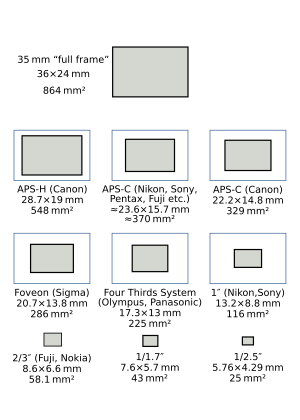APS-C
From Wikipedia, the free encyclopedia
Advanced Photo System type-C (APS-C) is an image sensor format approximately equivalent in size to the Advanced Photo System "classic" size negatives. These negatives were 25.1 × 16.7 mm and had an aspect ratio 3:2.
Sensors meeting these approximate dimensions are used in many digital single-lens reflex cameras, in addition to a few large-sensored live-preview digital cameras (such as the Sony DSC-R1 and the Sigma DP1) and a few digital rangefinders (e.g. the Epson R-D1). Such sensors exist in many different variants depending on the manufacturer and camera model[1]. All APS-C variants are considerably smaller than 35 mm standard film which measures 36×24 mm. Sensor sizes range from 20.7×13.8 mm to 28.7×19.1 mm. Each variant results in a slightly different angle of view from lenses at the same focal length and overall a much narrower angle of view compared to 35 mm film.
Contents |
[edit] Brand designations
Most DSLR and third party lens manufacturers now make lenses specifically designed for APS-C cameras. The designations by brand include:
[edit] Multiplier factors
A crop factor (sometimes referred to as a "focal length multiplier", even though the actual focal length is the same) can be used to calculate the 35 mm equivalent focal length from the actual focal length. The most common multiplier ratios (in order of announcements):
- 1.7× — Sigma SD14, Sigma SD10, Sigma SD9, Canon EOS DCS 3*
- 1.6× — Canon EOS 50D, 1000D, 40D, 400D, 30D, 450D, 20Da, 350D, 20D*, 300D*, 10D*, D60*, D30*
- 1.53× — Pentax *istD*, Pentax *istDs*, Pentax *istDs2*, Pentax *istDL*, Pentax *istDL2*, Pentax K100D*, Pentax K100D Super*, Pentax K10D, Pentax K20D, Pentax K200D
- 1.5× — all Nikon DSLR cameras except the D3, D3x and D700; all Fuji, Sony (except for the α 900), and Konica Minolta DSLR cameras.
- 1.3x↑ — Canon EOS-1D Mark III, 1D Mark II (and Mark II N), EOS-1D*, Kodak DCS 460*
* discontinued
↑ - A 1.3× Focal Length Multiplier is also known as APS-H. Actual multiplier factor is 1.25x, though commonly referred to as 1.3x
[edit] APS-C lens formats
Both Canon and Nikon have developed and designed lenses specifically for their cameras with a multiplier factor (also known as crop).
Canon introduced the Canon EF-S line of lenses in 2003 alongside the 300D. These lenses place the rear of the lens closer to the camera's sensor (referred to as short back focus). This has several benefits, including increasing the focal range. It also has drawbacks. The lenses are not compatible with any other Canon camera line (such as the EOS 5D or the 1D and 1Ds or any other film EOS camera).
Canon cameras that can use the EF-S mount include all entry-level Rebel series models and mid-range (xxD) Canon EOS digital bodies introduced after 2003 (this excludes the D30, D60, and 10D). These cameras support conventional 35 mm lenses as well.
Nikon has their DX format for their line of APS-C digital cameras. These can be mounted to the full-frame D3 and D700 models but only at 5 megapixels (compared the native output of 12 megapixels).
[edit] See also
[edit] References
- ^ Sensor Sizes, DPreview.com.



